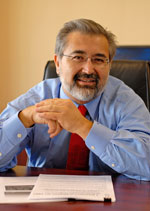|
If you are a tech investor, and you are not including Asian companies in your stock portfolio, I think you are ignoring some of the very best opportunities on the planet.
That’s because China is home to a huge, hidden tech mecca that can give Silicon Valley — and its investors — a run for their money.
More than 60% of Chinese technology exports are made by Taiwanese companies. What that means is that most of the technology profits coming from anything stamped with “Made in China” are probably going to Taiwan.
Today, I want to talk to you about Taiwan and why I believe “the other China” is where investors can start looking for the next big global investing opportunity.
Taiwan’s Rise to Tech-Sector Power
Taiwan, also known as the Republic of China, has been independent since the end of a civil war with China in 1949. A majority of the million Chiang Kai-shek supporters who fled to Taiwan were the Chinese who had the most to lose under communism — merchants, doctors, business owners and highly educated professionals.
Those entrepreneurial Chinese used their work ethic, drive, skills and business acumen to transform Taiwan from an underdeveloped agricultural island to an economic powerhouse that is one of the largest producers of high-tech goods on earth.
Today, Taiwan is the world’s largest computer-chip maker and a leading producer of LCD panels, DRAM computer memory, networking equipment, personal computers and consumer electronics.
Taiwan has its own high-tech metropolis, Hsinchu City, which rivals Silicon Valley.
Hsinchu City: The Silicon Valley of Asia
I had seen pictures and read all about it. But when I arrived in Hsinchu City recently, I was completely unprepared for what I was about to see.
My main reason for going: The Hsinchu Science Park, a government-sponsored technology mecca spread out over 1,500 acres … with 50,000 engineers … and six government-sponsored superlabs.
Hsinchu Science Park — the global epicenter of semiconductor research, design and manufacturing — is like Silicon Valley. Is it better than Silicon Valley, though?
Not really. But it’s a heck of a lot cheaper.
The work ethic of the typical worker would blow away most Americans: 10- to 12-hour workdays, six days a week, are the norm. Workers on this schedule make an average salary of about $1,830 a month, a fraction of the U.S. equivalent.
And that’s despite having science and math educations that significantly surpass most U.S. education systems.
Result: The tech companies here are getting far more science and engineering bang for their buck.
The innovations at Hsinchu Science Park are powered by its Industrial Technology Research Institute, a collection of labs with 40,000 engineers working closely with scientists at the Massachusetts Institute of Technology, the University of California at Berkeley and Carnegie Mellon.
The science park holds six government-sponsored laboratories: The National Center for High-Performance Computing, the Synchrotron Radiation Research Center, the National Space Program Office, the Instrument Technology Research Center, the Chip Implementation Center, and the National Nano Device Laboratory.
It also draws from two world-class universities: National Tsing Hua University and National Chiao Tung University, each cranking out a steady stream of highly qualified engineers and programmers.
Not Better Than Silicon Valley.
Just a Heck of a Lot Cheaper!
On average, wages in Taiwan average $1,900 per month, about half of the U.S. average of $3,700. And that’s despite science and math educations that significantly surpass most U.S. education systems.
End result: The tech companies of Taiwan and of Hsinchu in particular are getting far more science and engineering bang for their buck.
That’s even without the government-financed research. And it’s the government’s commitment to technology that has given Hsinchu Science Park with some of the largest, most-prosperous, most-impressive companies in the world.
And it’s easy to access several of them from the U.S. stock exchanges.
9 U.S.-listed Taiwan Stocks to Watch
Currently, there are nine Taiwanese companies that trade right here on the New York Stock Exchange and the Nasdaq:
- Advanced Semiconductor Engineering (ASX)
- AU Optronics (AUO)
- Chunghwa Telecom (CHT)
- Garmin (GRMN)
- Himax Technologies (HIMX)
- Silicon Motion (SIMO)
- Siliconware Precision Industries (SPIL)
- Taiwan Semiconductor Manufacturing (TSM)
- United Microelectronics (UMC)
You’ve probably never heard of most of those companies. But neither have most people, and that’s another reason I think the opportunity is potentially such a good one.
Taiwan Semiconductor, for example, is one of the largest in the world. Its corporate campus is the biggest I’ve seen my lifetime, covering dozens of city blocks.
AU Optronics, one of the largest flat-panel-display manufacturers in the world, is also impressive with 24,000 employees in a 12-story complex. But it looks like a tiny, drive-thru McDonald’s compared to Taiwan Semiconductor.
All told, more than 500 vibrant, fast-growing companies call Hsinchu City home, easily the largest concentration of high-tech companies anywhere outside of the sprawling Silicon Valley itself.
What to Do Next
I recently returned home from a research trip to Taiwan, and I’m excited about the investing prospects I found there.
However, as an American, it pains me to say that the land of opportunity for tech investors has moved across the Pacific Ocean. The world is changing, and what investors should be doing is changing along with it.
For tech investors, that means moving out of high-valuation, slow-growth U.S. tech stocks to their low-valuation, fast-growing Asian counterparts.
Both in China as well as the “other” China: Taiwan.
Best wishes,
Tony
